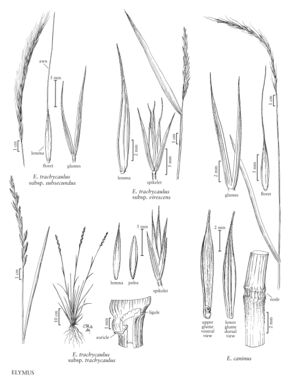Difference between revisions of "Elymus trachycaulus subsp. trachycaulus"
FNA>Volume Importer |
FNA>Volume Importer |
||
| Line 8: | Line 8: | ||
|name=Agropyron trachycaulum var. novae-angliae | |name=Agropyron trachycaulum var. novae-angliae | ||
|authority=unknown | |authority=unknown | ||
| − | }}{{Treatment/ID/Synonym | + | }} {{Treatment/ID/Synonym |
|name=Elymus trachycaulus subsp. teslinensis | |name=Elymus trachycaulus subsp. teslinensis | ||
|authority=unknown | |authority=unknown | ||
| − | }}{{Treatment/ID/Synonym | + | }} {{Treatment/ID/Synonym |
|name=Elymus trachycaulus subsp. novae-angliae | |name=Elymus trachycaulus subsp. novae-angliae | ||
|authority=unknown | |authority=unknown | ||
| − | }}{{Treatment/ID/Synonym | + | }} {{Treatment/ID/Synonym |
|name=Elymus trachycaulus subsp. major | |name=Elymus trachycaulus subsp. major | ||
|authority=unknown | |authority=unknown | ||
| − | }}{{Treatment/ID/Synonym | + | }} {{Treatment/ID/Synonym |
|name=Agropyron trachycaulum var. typicum | |name=Agropyron trachycaulum var. typicum | ||
|authority=unknown | |authority=unknown | ||
| − | }}{{Treatment/ID/Synonym | + | }} {{Treatment/ID/Synonym |
|name=Agropyron trachycaulum var. pilosiglume | |name=Agropyron trachycaulum var. pilosiglume | ||
|authority=unknown | |authority=unknown | ||
| − | }}{{Treatment/ID/Synonym | + | }} {{Treatment/ID/Synonym |
|name=Agropyron trachycaulum var. majus | |name=Agropyron trachycaulum var. majus | ||
|authority=unknown | |authority=unknown | ||
| − | }}{{Treatment/ID/Synonym | + | }} {{Treatment/ID/Synonym |
|name=Agropyron teslinense | |name=Agropyron teslinense | ||
|authority=unknown | |authority=unknown | ||
| − | }}{{Treatment/ID/Synonym | + | }} {{Treatment/ID/Synonym |
|name=Agropyron tenerum | |name=Agropyron tenerum | ||
|authority=unknown | |authority=unknown | ||
| − | }}{{Treatment/ID/Synonym | + | }} {{Treatment/ID/Synonym |
|name=Agropyron pauciflorum | |name=Agropyron pauciflorum | ||
|authority=unknown | |authority=unknown | ||
| − | }}{{Treatment/ID/Synonym | + | }} {{Treatment/ID/Synonym |
|name=Agropyron caninum var. tenerum | |name=Agropyron caninum var. tenerum | ||
|authority=unknown | |authority=unknown | ||
| − | }}{{Treatment/ID/Synonym | + | }} {{Treatment/ID/Synonym |
|name=Agropyron caninum var. majus | |name=Agropyron caninum var. majus | ||
|authority=unknown | |authority=unknown | ||
| − | }}{{Treatment/ID/Synonym | + | }} {{Treatment/ID/Synonym |
|name=Agropyron caninum subsp. majus | |name=Agropyron caninum subsp. majus | ||
|authority=unknown | |authority=unknown | ||
| − | }}{{Treatment/ID/Synonym | + | }} {{Treatment/ID/Synonym |
|name=Agropyron caninum var. bornemannii | |name=Agropyron caninum var. bornemannii | ||
|authority=unknown | |authority=unknown | ||
| Line 58: | Line 58: | ||
-->{{Treatment/Body | -->{{Treatment/Body | ||
| − | |discussion=<p>Elymus trachycaulus subsp. trachycaulus grows throughout the habitat and range of the species, and exhibits considerably more variation than subsp. subsecundus. Two aspects of the variation that seem particularly worthy of further study are the glume venation and the spacing of spikelets in the spikes. Plants with glumes having 5-7 well-developed, narrowly spaced veins are restricted to lower elevations and the southern portion of the subspecies range; northern plants and plants at higher elevations generally have 3-5 weakly developed and widely spaced veins. The former glumes resemble those of E. glaucus, with which E. trachycaulus subsp. trachycaulus is often sympatric; the latter, those of E. violaceus (p. 324). Spikelet spacing also varies considerably. In at least some instances, plants with widely spaced spikelets appear to be associated with more shady habitats.</p> | + | |discussion=<p><i>Elymus trachycaulus </i>subsp.<i> trachycaulus</i> grows throughout the habitat and range of the species, and exhibits considerably more variation than <i></i>subsp.<i> subsecundus</i>. Two aspects of the variation that seem particularly worthy of further study are the glume venation and the spacing of spikelets in the spikes. Plants with glumes having 5-7 well-developed, narrowly spaced veins are restricted to lower elevations and the southern portion of the subspecies range; northern plants and plants at higher elevations generally have 3-5 weakly developed and widely spaced veins. The former glumes resemble those of <i>E. glaucus</i>, with which <i>E. trachycaulus </i>subsp.<i> trachycaulus</i> is often sympatric; the latter, those of <i>E. violaceus</i> (p. 324). Spikelet spacing also varies considerably. In at least some instances, plants with widely spaced spikelets appear to be associated with more shady habitats.</p> |
|tables= | |tables= | ||
|references= | |references= | ||
| Line 78: | Line 78: | ||
|publication year= | |publication year= | ||
|special status= | |special status= | ||
| − | |source xml=https://jpend@bitbucket.org/aafc-mbb/fna-data-curation.git/src/ | + | |source xml=https://jpend@bitbucket.org/aafc-mbb/fna-data-curation.git/src/8f726806613d60c220dc4493de13607dd3150896/coarse_grained_fna_xml/V24/V24_453.xml |
|subfamily=Poaceae subfam. Pooideae | |subfamily=Poaceae subfam. Pooideae | ||
|tribe=Poaceae tribe Triticeae | |tribe=Poaceae tribe Triticeae | ||
Revision as of 16:20, 18 September 2019
Culms 30-150 cm. Spikes (4)8-30 cm long, 0.5-0.8 cm wide, 2-sided; internodes 8-15 mm. Spikelets with 3-9 florets, the bases usually visible. Glumes 5-17 mm, at least 1 vein scabrous to near the base, sometimes all veins scabrous, unawned or with straight awns shorter than 2 mm; lemmas unawned or awned, awns to 5 mm, straight.
Discussion
Elymus trachycaulus subsp. trachycaulus grows throughout the habitat and range of the species, and exhibits considerably more variation than subsp. subsecundus. Two aspects of the variation that seem particularly worthy of further study are the glume venation and the spacing of spikelets in the spikes. Plants with glumes having 5-7 well-developed, narrowly spaced veins are restricted to lower elevations and the southern portion of the subspecies range; northern plants and plants at higher elevations generally have 3-5 weakly developed and widely spaced veins. The former glumes resemble those of E. glaucus, with which E. trachycaulus subsp. trachycaulus is often sympatric; the latter, those of E. violaceus (p. 324). Spikelet spacing also varies considerably. In at least some instances, plants with widely spaced spikelets appear to be associated with more shady habitats.
Selected References
None.
